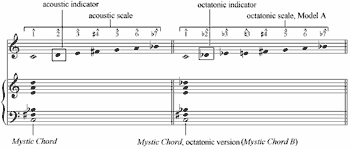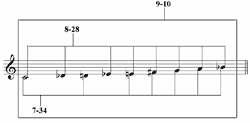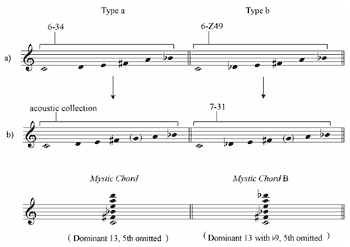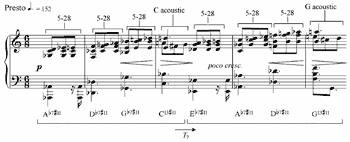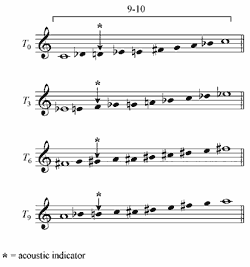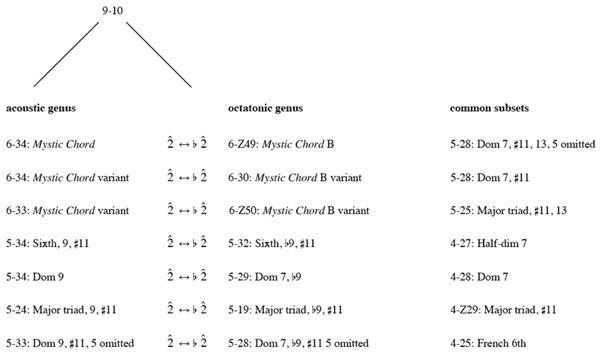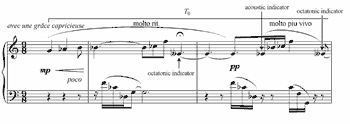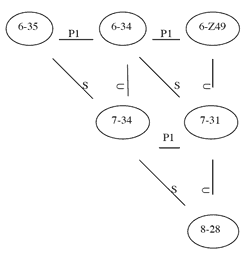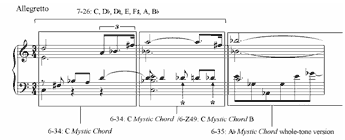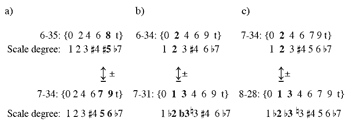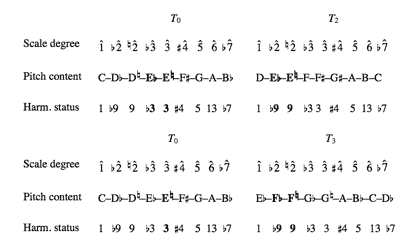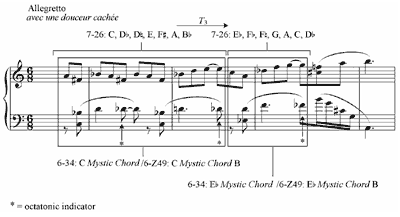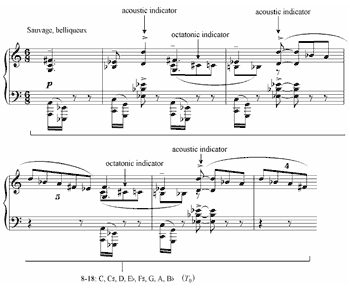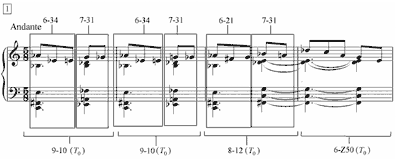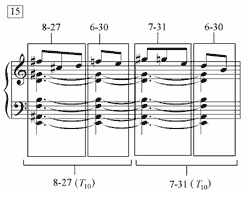Principles of Pitch Organization in Scriabin’s Early Post-tonal Period: The Piano Miniatures
Vasilis Kallis
Dedicated to the memory of Anthony Pople
KEYWORDS: Scriabin, piano miniatures, octatonic scale, acoustic scale, whole-tone scale, pitch substitution, genus transformation
ABSTRACT: Scriabin’s post-tonal period, which begins around 1909 with Feuillet d’album, Op. 58, is defined by the subtle and sophisticated exploitation of some special non-diatonic sets and their pitch universes: (i) the acoustic scale: 0, 2, 4, 6, 7, 9, t (member of set-class 7-34), the parent scale of the Mystic Chord; (ii) the octatonic scale, Model Α: 0, 1, 3, 4, 6, 7, 9, t (member of set-class 8-28); and (iii) 9-10: 0, 1, 2, 3, 4, 6, 7, 9, t (the nine-note superset that arises from the union of the acoustic and the octatonic scales). Close examination of the post-Op. 58 works allows us to partition the late style into two periods: early, from Op. 58 to Op. 69 inclusive; and late, from Op. 70 to the final creation, Op. 74. During his early post-tonal period, Scriabin developed a pitch organization method based on the interaction between the acoustic and octatonic scales within the constraints of their nonachordal common superset 9-10. This essay examines the specifics and the application of the acoustic-octatonic interaction in the composer’s miniature pieces written in his early post-tonal period.
Copyright © 2008 Society for Music Theory
[1.1] Scriabin’s post-tonal period, which begins around 1909 with Feuillet d’album, Op. 58, is defined by the subtle and sophisticated exploitation of some special non-diatonic sets and their pitch universes: (i) the acoustic scale: 0, 2, 4, 6, 7, 9, t (member of set-class 7-34), the parent scale of the Mystic Chord;(1) (ii) the octatonic scale, Model Α: 0, 1, 3, 4, 6, 7, 9, t (member of set-class 8-28); and (iii) 9-10: 0, 1, 2, 3, 4, 6, 7, 9, t (the nine-note superset that arises from the union of the acoustic and the octatonic scales).(2) See Example 1. Close examination of the post-Op. 58 works allows us to partition the late style into two periods: early, from Op. 58 to Op. 69 inclusive; and late, from Op. 70 to the final creation, Op. 74. During his early post-tonal period, Scriabin developed a pitch organization method based on the interaction between the acoustic and octatonic scales within the constraints of their nonachordal common superset 9-10. Other pitch entities appear as well, but their functional role is supplementary until they are integrated into a coherent style in the Tenth Sonata, Op. 70, which marks the beginning of the composer’s final period.
[1.2] This essay considers Scriabin’s method of pitch syntax in his early post-tonal period (1909–12) through the examination of miniature piano pieces. Since the composer was writing these to master his craft, they constitute valuable source material for the study of his pitch organization.(3)
Example 2. Model of pitch organization in Scriabin
(click to enlarge)
Example 3. Generation of 9-10 from the union of the acoustic and the octatonic scales
(click to enlarge)
[1.3] Scriabin’s method of pitch organization centers on the chromatic possibilities available through the pitch relationship between the acoustic (labeled as such for its similitude to the overtone series) and the octatonic scales.(4) These closely related scales share a common hexachordal subset (6-Z23), which allows the remaining pitches—one, D (![]() ), exclusively acoustic, the other two,
), exclusively acoustic, the other two, ![]()
![]()
![]()
![]()
![]()
![]()
![]() in the acoustic and
in the acoustic and ![]()
![]()
![]() and
and ![]()
![]()
![]() and
and ![]()
![]()
[1.4] Although there is more than one way to define the relationship between 9-10 and the acoustic and octatonic scales, Scriabin’s compositional practice (which unequivocally treats the heptachord and the octachord as gestalts) allows us to view 9-10 as the union of the pitch content of its two subsets (Example 3).(5) In fact, 9-10 is the only nine-note superset of the octatonic scale and the smallest common superset of the latter and the acoustic scale. It constitutes the superset under the auspices of which the acoustic scale and the octatonic scale, Model Α interpenetrate one another, and, additionally, its pitch constraints form the chromatic pitch gamut of the phrase units that shape the musical surface.
[1.5] The pitch entities in Example 1 and all their subsets are treated not as abstract set-classes, but as specific ordered non-diatonic scales. “Ordered” means that a specific pitch center is imposed on which specific harmonies (Mystic Chord, Mystic Chord B, and their variants) are built. In Scriabin’s early post-tonal period, both the acoustic and the octatonic scales have their pitch center on the pitch on which the Mystic Chord and Mystic Chord B, respectively, are built. This approach restricts the octatonic scale to one of its two rotations, semitone-tone, Van den Toorn’s Model Α. The correlation with the specific pitch centricity refers not only to the acoustic and the octatonic scales, but also to their subsets employed in the composer’s early post-tonal œuvre.
[1.6] Scriabin’s principles of pitch organization have preoccupied scholars from the first moment that his post-tonal works earned a place in the twentieth-century repertory. It is particularly in the work of M. Kelkel, Anthony Pople, and Fred Lerdahl that we find apt analytical descriptions of Scriabin’s octatonic/acoustic (and thus 9-10) ventures.(6)
[1.7] Kelkel realizes the structural significance of the composer’s chromatic schemes in formalizing a language based on the exploitation of different harmonic/modal types. The most significant of his observations is the proposed distinction between two harmonic and modal types. The Mystic Chord and Mystic Chord B correspond to the acoustic scale and the octatonic heptachord 7-31 respectively (Example 4).
[1.8] Pople’s study of the Prelude, Op. 67, No. 1 presents a well-buttressed effort to decode Scriabin’s peculiar octatonic practices, especially in conjunction with 9-10, which Pople treats as a new normative set “regarded as being composed-out against the normative background of the octatonic set [0,1,3,4,6,7,9,10].”(7) Similarly to Pople, Lerdahl also correlates the octatonic scale with 9-10, but in addition he brings the acoustic scale to the fore. His analysis of Op. 67, No. 1 offers a precise description of the relationship between the three scales and their role in Scriabin’s method of pitch-organization.(8)
[1.9] The most significant aspect with regard to the history of the acoustic scale and 9-10 is not so much the lack of acknowledgment, but the failure to realize the specifics of the dialectic between the acoustic and the octatonic scales, not least of the chromatic interplay between ![]() /
/![]()
![]() .(9)
.(9)
[1.10] This structure, for example, saturates the musical surface in the outer sections of the Scherzo, Op. 46, a work well into the composer’s transitional period. Example 5 shows measures 1–4, which articulate two T7 related phrases. Apart from the downbeat of measures 2 and 4, the music unfolds a succession of a single type of dominant harmony, a dominant seventh with a raised eleventh (set class 5-28), a structure prophetic of the Mystic Chord (the ![]()
![]()
Issues of pitch organization
The octatonic scale
Example 6. 9-10, T3 operation
(click to enlarge)
Example 7. Octatonic scale, array of harmonies in Scriabin’s post-tonal oeuvre
(click to enlarge and see the rest)
Example 8. Acoustic scale, array of harmonies in Scriabin’s post-tonal oeuvre
(click to enlarge and see the rest)
[2.1] The octatonic scale is invariant at four distinct transpositional levels: T0, T3, T6, and T9 will keep the pitch content of the scale intact. The symmetrical properties of the scale are transferred within 9-10 as well: it remains the symmetrical component of its superset, which is itself an asymmetrical entity. In fact, the cyclical application of T3 to 9-10 yields quite interesting results that merit attention. It keeps the octatonic component within 9-10 invariant. However, it brings forth a new pitch, the second scale degree of the acoustic component, which is an extremely important technical detail in Scriabin’s compositional approach. See Example 6. This means that while the cyclical transposition of any 9-10 by interval-class 3 will keep a single form of the octatonic scale intact, at the same time it will yield four distinct 9-10s and four distinct acoustic scales. These provide a “new” pitch at each transposition, which is none other than the acoustic indicator. In addition, the three acoustic indicators found in the T3, T6, and T9 forms of the original T0 of 9-10 are the three pitches that, when added to 9-10, bring about the complete chromatic aggregate.
[2.2] Scriabin’s method of pitch organization makes exclusive use of the octatonic scale, Model Α, the rotation of 8-28 able to provide major and minor triads (as well as other tertian harmonies) built on the first note of the scale, which also lines up as closely as possible with the canonical ordering of the acoustic scale. Of the many harmonic structures built on the tonic of the octatonic scale, Model Α, Scriabin favors specific dominant-type, yet tonally non-functional, extended and altered harmonies: more specifically, Mystic Chord B, its variants, and some pentachordal subsets. See Example 7.(10)
The acoustic scale
[2.3] The acoustic scale is a transpositionally asymmetrical entity; it is not invariant under any transposition. Its value in Scriabin’s pitch-syntactic routines lies in its close pitch relationship with the octatonic scale, and in that it contributes the only non-octatonic pitch within 9-10, the acoustic indicator.
[2.4] In addition to the variety of harmonic structures available within its harmonic depository, the acoustic scale exhibits an explicit functional distinction among its seven scale degrees. Scriabin, nevertheless, focuses on a single scale degree, the tonic, and, similar to what he does with the octatonic scale, utilizes only specific dominant-type extended and altered structures, namely, the Mystic Chord and specific variants. See Example 8. The role of the Mystic Chord is essential, not only because of its special status in the composer’s method of pitch organization, but also because the acoustic and octatonic (especially Mystic Chord B) structures featured in Scriabin’s post-tonal œuvre are directly related to it. The correspondence between the voicing of the acoustic and the octatonic structures is probably a result of the special emphasis given to the Mystic Chord as the emerging harmonic foundation in the composer’s routines for pitch organization.(11)
[2.5] The acoustic and octatonic scales interact with one another by way of common subsets, a vital technical attribute in Scriabin’s method of pitch organization. This approach promotes parsimonious voice-leading, which (i) ensures the smooth transformation from one scale to the other and (ii) permits the direct conflict between the members of the chromatic dyad formed by the acoustic and the octatonic indicators (![]() and
and ![]()
![]() ,
,
[2.6] How, then, do the peculiar interrelationships in the octatonic/acoustic universe make themselves available in Scriabin’s model of pitch organization? The inspection of Scriabin’s approach to harmony places the Mystic Chord (6-34) and its octatonic version (6-Z49) at center stage. Both of these harmonies remain basic to the composer’s harmonic palette and constitute the central point of harmonic reference in the early post-tonal style. All the other harmonic structures deployed are directly related to this harmonic core. Several hexachordal variants are encountered: two related to the Mystic Chord (6-34, 6-33), two related to Mystic Chord B (6-30, 6-Z50), and one common to both (6-Z23). Specific pentachordal substructures are also articulated when the several forms of the Mystic Chord appear as incomplete sonorities. Harmonic structures with fewer than five pitch members are deployed sparingly, if at all. These structures may appear, usually in the left hand, before other chord members enter melodically in the right hand to form (by integrating the vertical with the horizontal) one or another of the composer’s trademark harmonies.
[2.7] The two pitch genera, as mentioned above, interact primarily through common structures. Figure 1 shows the specific details of this procedure. Column 1 lists the acoustic structures. The column next to it displays the corresponding octatonic structures. The last column shows the common acoustic/octatonic subsets that act as mediators in the specific interaction process. All the harmonic structures in columns 1 and 2 include the acoustic/octatonic indicator (![]() /
/![]()
![]() ),
),![]() /
/![]()
![]()
![]() ), third (
), third (![]() ), seventh
), seventh ![]()
![]() ),
),![]()
![]() ).
).
[2.8] Scriabin’s treatment of these pitch phenomena in relation to pitch organization prompts the following general observations:
-
The phrase structure is organized in chunks of music that constitute self-contained “blocks” in which the acoustic/octatonic structural associations are articulated on a single pitch center. (These “blocks” form motivic segments or entire phrase units.) Motivic and thematic designs, as well as the contrapuntal network that assures their interconnection, tend to emphasize the melodic argument between the two members of the
 /
/

-
There are four fixed scale degrees that are almost always present:
 ,
, 
 ,
,
 ,
,
 .
. and
and  .
.


 .
.




 .
. -
These “blocks” are usually transposed by either one of the two fundamental intervals (or their multiples) within the acoustic and the octatonic genus: ic-2 and ic-3 respectively. Ultimately, a work’s transposition structure is used as a means to promote the presence of the acoustic scale, the octatonic scale, and 9-10, at the deepest levels of structure. Scriabin’s transpositional levels tend to avoid the three pitches not present in the pitch content of 9-10 (and, by convention, in the pitch content of the acoustic and octatonic collection as well), i.e. scale degrees
 ,
,  and
and 
 .
.

G –
G –
A –
A –
B –C–
E (member of the 9-10 subset 7-10) and C–
C –
E –
F –G–A (member of the octatonic subset 6-30), respectively at deeper levels of structure.(12) Op. 69, No. 1 promotes
C–C (member of 8-27), which may be partitioned into the octatonic heptachord (7-31) plus –E
–E –E
–E –F
–F –G–G
–G–G –B
–B
G (

 ).
).

-
The persistence with which the specific dialectic between the acoustic and the octatonic scales appears in the composer’s early post-tonal period suggests a remarkable syntactic unity. Moreover, the acoustic scale, the octatonic scale, Model Α, and 9-10, as well as the Mystic Chord and Mystic Chord B, become conventionalized in the composer’s early post-tonal period through continual usage.
[2.9] Let us see how this approach works in practice. The opening phrase (measures 1–3) of the Poème-Nocturne, Op. 61 immediately introduces a subtle dialectic between the acoustic and the octatonic genera within the pitch constraints of superset 9-10. See Example 9. (Henceforth, we assign 0 to the pitch center of the original phrase unit.) Scriabin introduces chromaticism in terms of the chromatic dyad formed by the acoustic and octatonic indicators, E![]() and
and ![]()
![]() ,
,![]() Mystic Chord variant (5-28:
Mystic Chord variant (5-28: ![]() –F–G–B
–F–G–B![]() –C
–C![]() ).
).![]()
![]()
![]()
![]()
![]()
[2.10] Identical acoustic/octatonic interpenetrations occur in the subsequent phrase at measures 4–7, a modified T2 transposition of the original phrase unit (see Example 9). However, this time the incomplete introductory measure of the T0 unit becomes a full measure with the addition of a Mystic Chord B variant whose pitches, despite the orthographical inconsistency, are drawn exclusively from E![]() octatonic, Model Α:
octatonic, Model Α: ![]() –F
–F![]() –F
–F![]() –A–B
–A–B![]() –C
–C![]()
![]() )
)![]() )
)![]() /
/![]()
![]()
![]() .
.![]()
![]()
![]()
Voice-leading parsimony: a model of interaction
Figure 2. Substitution-based interaction: network of set interrelationships, from Callender (1998, Fig. 11, p. 227)
(click to enlarge)
Figure 3. Voice-leading between P1-related sets
(click to enlarge )
[3.1] The treatment of the acoustic and octatonic scales in Scriabin’s method of pitch organization conforms to a broader network of set interaction based on voice-leading parsimony between closely related set-pairs of equal and unequal rank. This procedure promotes genus transformations by way of pitch substitution, pitch addition/omission, and pitch splitting. The abstract relationships between Scriabin’s preferred scales discussed below are presented in Clifton Callender’s study of the composer’s voice-leading routines.(13) Consider Figure 2 (Callender’s Figure 11),(14) which epitomizes the technical specifics of this relational network in terms of the composer’s primary scales and three important subsets: 7-31, 6-34 (Mystic Chord), and 6-Z49 (Mystic Chord B). Horizontal connections involve set-pairs of equal cardinality, which form the P1 relation with one another. As we see from the three P1-related pairs (6-35/6-34, 6-34/6-Z49, 7-34/7-31), transformations between them require nothing more than a single chromatic alteration (or pitch substitution). See Figures 2 and 3. A single pc is subjected to alteration by ± 1 semitone to yield its substitute and effect the scalar transformation.
[3.2] The first two measures of Poème-Nocturne, Op. 61 (Example 9 above) are a paradigm of this kind of interaction; they exhibit a transformation from 6-Z49 (Mystic Chord B on ![]() )
)![]() )
)![]()
![]()
![]() .
.![]() /
/![]()
![]()
![]()
![]() –A–B
–A–B![]()
![]() –E–F
–E–F![]() –A–B
–A–B![]() .
.![]()
![]() –B
–B![]() –C–D–E–G
–C–D–E–G![]() )
)![]() ,
,![]() –G
–G![]() –A
–A![]() –C
–C![]() –D).(15)
–D).(15)![]()
|
Example 10a. Scriabin, Poème, Op. 69, No. 1, mm. 1–6 (click to enlarge and see the rest) |
Example 10b. Scriabin, Poème, Op. 69, No. 1, mm. 1–5, acoustic/whole-tone interaction (click to enlarge) |
Example 11. Scriabin, Etrangeté, Op. 63, No. 2
(click to enlarge and see the rest)
Figure 4. Voice-leading between S-related sets
(click to enlarge )
[3.3] Vertical set connections in Figure 2 involve sets related by inclusion. This means that their interconnections do not require any pitch inflections, but are carried out by pitch addition or pitch omission. Sets connected vertically are representatives of the same pitch genus, be it octatonic or acoustic. The decision as to which set (the inaugural set or specific subsets) is used at the musical surface relies on contextual requirements. The octatonic heptachord of the first two measures of Etrangeté, for example, is succeeded by 6-Z49, which eliminates ![]()
![]()
![]() ),
),
[3.4] Sets connected diagonally (from the upper left to the lower right corner) form the S-relation, which involves sets with a cardinality difference of ±1 (see Figure 2 above). S splits a pc to yield its upper and lower chromatic neighbors and vice versa. Three pairs (6-35/7-34, 6-34/7-31, and 7-34/8-28) are S-related to one another. Figure 4 demonstrates the abstract manifestation of this type of interpenetration. However, due to his approach to pitch organization, Scriabin does not particularly exploit the S-relation in the miniatures of his early post-tonal period. As seen in Figure 4, the S-relation involving the pairs 6-34/7-31 and 7-34/8-28 requires the presence of ![]()
![]()
![]()
![]()
![]()
![]()
![]()
![]() and
and ![]()
![]()
![]()
![]()
![]()
![]() )
)
[3.5] What Scriabin promotes instead is the combination of vertical (inclusion) and horizontal (P1) motion shown in Figure 2. This operation involves sets with a ±1 difference in cardinality and incorporates the ![]() /
/![]()
![]()
![]() )
)![]() ,
,![]() –E–F
–E–F![]() –A–B
–A–B![]() )
)![]() –E–F
–E–F![]() –B
–B![]() ),
),![]()
![]() )
)
[3.6] An important issue as to the nature of the pitch interrelationships within 9-10 emerges at this point. Does the music effect the juxtaposition of the acoustic and the octatonic scales by means that promote pitch substitution in terms of ![]() and
and ![]()
![]()
![]() /
/![]()
![]()
![]() 9
9![]()
![]() )
)![]() 9
9![]()
![]() )
)![]() /
/![]()
![]()
![]() ,
,
[3.7] Two technical details show that pitch substitution constitutes a fundamental feature of Scriabin’s method of pitch organization: (i) in his approach to voice-leading, the acoustic and octatonic indicators are always treated as adjacencies in the same voice; and (ii) certain pitches are selectively and systematically omitted from the pitch content of adjacent, transpositionally related, phrase units . Let us see how this is practiced in Op. 61 (Example 9 above). The sum of the pitches of T0 yields the 9-10 octachord 8-27: ![]() –E
–E![]()
![]() –E
–E![]() –( )–F–G–A
–( )–F–G–A![]() –B
–B![]() –C
–C![]() . E
. E![]() (
(![]()
![]() )
)![]()
![]()
![]()
![]() –F
–F![]() –F
–F![]() –F
–F![]() –G–A–B
–G–A–B![]() –C–D
–C–D![]()
![]() ).
).![]() to E
to E![]()
![]()
![]()
![]()
[3.8] The emphasis on the conflict between the two modal indicators emerges as a crucial compositional device. In fact, inspection reveals that, in his effort to allow at least one of the two modal indicators to appear as a “new” pitch, Scriabin enforces a plan that promotes the correlation between pitch content and transposition interval. See Table 1. In the T3, T6, and T9 operations, the acoustic indicator (![]() ) is not present in the original (T0) form of 9-10; it always articulates itself as a “new” pitch, as does the octatonic indicator
) is not present in the original (T0) form of 9-10; it always articulates itself as a “new” pitch, as does the octatonic indicator ![]()
![]() )
)![]()
![]() ,
,![]() /
/![]()
![]() )
)
[3.9] Poème-Nocturne, Op. 61, Op. 63, No. 2, the prelude from Op. 59, and Op. 69, No. 1 exemplify this approach. Poème-Nocturne begins with the 9-10 octachord 8-27 on ![]() :
:![]() –E
–E![]()
![]() –E
–E![]() –(F
–(F![]() )–F–G–A
)–F–G–A![]() –B
–B![]() –C
–C![]() .
.![]() ,
,![]() –F
–F![]() –F
–F![]() –G
–G![]() –G
–G![]() –A–B
–A–B![]() –C–D
–C–D![]() .
.![]() ,
,![]() (
(![]()
![]() ),
),![]() .
.![]()
Example 12. Scriabin, Masque, Op. 63, No. 1, mm. 1–4
(click to enlarge )
Example 13. Scriabin, Prelude, Op. 59, No. 2, mm. 1–5
(click to enlarge)
[3.10] However, in Op. 63, No. 1 the change to a different transposition interval (ic-3) dictates a different approach. See Example 12. The acoustic indicator in T3 is, by convention, a “new” pitch (it is the only pitch in T3 missing from T0). Hence, in order to find common harmonic ground between the acoustic and the octatonic scales, Scriabin simply removes the other exclusively octatonic pitch ![]() (
(![]()
![]() )
)![]() /
/![]()
![]()
![]()
![]() ,
,
[3.11] In contrast, in the Prelude, Op. 59, No. 2, ![]()
![]()
![]()
![]()
![]()
![]()
![]()
![]()
![]()
T0: C–D![]() –D
–D![]() –E
–E![]() –F
–F![]() –G–A–B
–G–A–B![]()
T3: E![]() –F
–F![]() –F
–F![]() –G
–G![]() –A–B
–A–B![]() –C–D
–C–D![]()
T6: F![]() –G–G
–G–G![]() –A –B
–A –B![]() –C
–C![]() –D
–D![]() –E
–E
T9: A–A![]() –B–C–D
–B–C–D![]() –E–F
–E–F![]() –G
–G
T12: C–D![]() –D
–D![]() –E
–E![]() –F
–F![]() –G–A–B
–G–A–B![]()
[3.12] Now consider T4. Opus 69, No. 1 (Example 10a above) provides a paradigmatic example of how this particular operation lays emphasis on the ![]() /
/![]()
![]()
![]() –D
–D![]() –E–F
–E–F![]() –A–B
–A–B![]() )
)![]() ,
,![]() –G
–G![]() –A
–A![]() –C
–C![]() –D
–D![]() represents one of the three pitches absent from 9-10), the octatonic indicator
represents one of the three pitches absent from 9-10), the octatonic indicator ![]()
Example 14. Scriabin, Poème-Nocturne, Op. 61, mm. 159–72
(click to enlarge and see the rest)
Figure 5
(click to enlarge )
Example 15a. Scriabin, Prelude, Op. 67, No. 1, mm. 1–6. Based on Pople
(click to enlarge and see the rest)
Example 15b. Scriabin, Prelude, Op. 67, No. 1, mm. 15–16
(click to enlarge)
[3.13] The concluding stages of Poème-Nocturne, Op. 61 provide further evidence of the compositional value of the ![]() /
/![]()
![]()
![]()
![]() –E
–E![]()
![]() –F–G–A
–F–G–A![]() –B
–B![]() ),
),![]() /E
/E![]()
![]()
[3.14] To further intensify the effect, Scriabin deprives the octatonic indicator of its harmonic clothing: in the last six measures, ![]()
![]()
[3.15] In contrast, the Prelude, Op. 67, No. 1 features segments that resort to combination. Pople demonstrates that the vast majority of the proposed segments are governed by superset 9-10 or by specific 9-10 subsets.(19) Our concern here is with the pitch content and pitch interrelationships in terms of the acoustic and octatonic scales within each segment. Measures 1–6 and 15–16, taken as samples (every measure constitutes a segment here), present the following set successions (Example 15):(20)
[3.16] The first six segments (measures 1–6) are governed by the T0 form of 9-10: ![]() –G
–G![]() –A
–A![]() –A
–A![]() – B
– B![]() –C–D
–C–D![]() –E
–E![]() –F
–F![]() .
.![]()
![]()
![]()
![]()
![]()
![]() )
)
[3.17] A similar approach is encountered in Op. 59, No. 2. See Example 13 above. T0 (the opening phrase unit at measures 1–5), utilizes the 9-10 octachord 8-18: ![]() –D–E
–D–E![]() –F
–F![]() –G–A–B
–G–A–B![]()
![]()
![]()
![]()
![]()
![]() )
)![]() : C–D–E
: C–D–E![]() –G–B
–G–B![]() .(24)
.(24)![]() ,
,
[3.18] We may draw the following conclusions regarding Scriabin’s approach to pitch organization. Pitch substitution, and thus structural chromaticism in terms of the chromatic dyad ![]() /
/![]()
![]() ,
,
[3.19] Pitch substitution involves either “blocks” that bear the distinctive aura of their parent scale (i.e., Op. 61, measures 159–72) or structures that are subsets of both 7-34 and 8-28, which leave the play of identities to the acoustic/octatonic indicators (i.e., Op. 61, measures 1–7, Op. 69, No. 1, measures 2 and 6). This invites a welcome dialectic that produces a well-controlled, subtle, perpetual change or mixture of “color.” In that sense, chromaticism, subtle as it is, acts not only as an agent of modal mutation, but above all as a primary compositional determinant with respect to the idea of development, the idea of “change” and “progress.”
Pitch material and form
[4.1] With the exception of Op. 61, all of the piano miniatures that Scriabin wrote in the early post-tonal period are cast in part forms: binary, ternary, and rondo. With regard to large structure, these forms exhibit two primary formal functions: (i) development (embedded within the motion away from and back to the primary “tonality”), which includes motivic and thematic development to varying extents, and (ii) contrast, which depends largely on harmonic and tonal/modal “change.” In the tonal era, “change” was principally accommodated by the modulation from one tonal center to another, subject to context. In twentieth-century music, composers also relied on cross-collectional interaction, which usually involves more than two scales and, more importantly, provides an effective means to emphasize the individual “color” imposed by each scale’s unique interval content. The correlation between genus and formal unit is an important form-determining device, as exemplified in Richard Park’s analytical work on Debussy.(25) In the piano prelude Feuilles mortes,
for example, “each formal unit is associated with one or another genus.”(26) However, in contrast to composers such as Debussy, Stravinsky, Bartók, and Ravel, Scriabin does not shift between scales at the beginnings of new sections. His “modulations” rarely pursue the distinction of character between formal boundaries that are found so often in early twentieth-century repertories. Instead, he largely relies on a subtle cross-collectional dialectic on a single pitch center within the phrase unit that is accommodated by pitch invariance and intensified by ![]() /
/![]()
![]()
[4.2] In addition, at the local level, decorative chromatic tones appear very sparingly. One of these is the B (measures 2 and 4) in the Prelude, Op. 59, No. 2 (see Example 13 above), which is an accented passing tone that falls out of the pitch domain of the local reference scale. The insertion of chromatic tones within principal melodic statements, not to mention modulatory passages of any kind, has for centuries been an extremely resourceful means of elaboration in modal, tonal, or post-tonal contexts. On several occasions, if not in several styles, it has also been a structural arbiter of such basic musical parameters as harmony, phrase structure and form.(27) Thus, constraining the pitch content of each phrase to a maximum of nine pitches has a radical effect on musical meaning. In one sense, Scriabin not only employs limited pitch resources (single-type harmonies on a single scale degree), he also appears to deprive his music of the widely applicable techniques of pitch elaboration that would compensate for any loss of interest.
[4.3] Why then does Scriabin refrain from such a powerful compositional resource? In fact, he does not. The lack of a correlation between genus and formal unit and the absence of the chromatic aggregate within the local phrases are balanced by a subtly articulated transpositional modus operandi that exploits pitch content and transposition interval to ensure the presence of either the acoustic or the octatonic indicator as “new” pitches at the various transpositions of the original phrase unit. At the same time, the ![]() /
/![]()
![]()
[4.4] In addition, while the pitch total of phrase transpositions very rarely exceeds the pitch gamut of 9-10, Scriabin’s approach allows the music ultimately to unfold the chromatic aggregate in a procedure that operates beneath the musical surface. The whole operation spans longer chunks of musical time, in which the acoustic indicator provides the three missing pitches at T3, T6, and T9; occasionally, such chunks govern an entire composition, as in the case of Op. 59, No. 2. Structural chromaticism, both local and far-reaching, along with the gradual unfolding of the chromatic aggregate, offers an effective means to overcome the constraining aspects of Scriabin’s pitch resources. To continue with the same line of thought, the occasional interpolation of whole-tone “blocks” invites a welcome change of “harmonic color.”
[5.1] The present article proposes an analytical model as a means to decode the methods of pitch syntax practiced by Scriabin in his early post-tonal period. It aims to present an ample and coherent exegesis of the many peculiarities that characterize Scriabin’s musical idiom. The development of this particular analytical model has been based on its consistent manifestation in the miniature piano pieces between Opp. 59 and 69, inclusive. Inspection reveals that Scriabin persistently insists on the specifics of the acoustic/octatonic argument. One can observe it saturating the musical surface in Op. 59, Nos. 1 and 2, Opus 61, Op. 63, Nos. 1 and 2, Op. 65, No. 2, Op. 67, No. 1, and Op. 69, Nos. 1 and 2. The acoustic/octatonic argument is also a principal feature in Op. 65, Nos. 1 and 3 and Op. 67, No. 2.(28) Nevertheless, it is integrated within the broader syntactic scheme that appears fully developed in the Tenth Sonata, the first work of Scriabin’s final post-tonal period.
[5.2] The persistent use of the acoustic/octatonic argument suggests more than just the integrity of the proposed analytical model. Acting as an arbiter of cohesion in the composer’s early post-tonal period, it reveals a remarkable unity of style, a style that is unique because of the ingenuity with which its primary ingredients are intermingled. Scriabin is not alone in deploying stock-of-the-day pitch material. The Russians and other
Eastern Europeans, as well as the French, had been using the octatonic, the whole-tone, and the acoustic scales well before their initial appearance in Scriabin’s œuvre. What distinguishes Scriabin from his contemporaries is the method he devises to exploit his primary pitch resource, in particular the ![]() /
/![]()
![]()
[5.3] The use of chromaticism, either in terms of ![]() and its inflection or of other chromatic counterparts, which remains conspicuous in every stage of the composer’s stylistic evolution, constitutes a vital technical attribute. This kind of pitch-syntactic consistency raises the possibility that the analytical model that was intended to cope with the pitch issues within the early post-tonal miniatures could also be applicable to the composer’s entire post-tonal œuvre.
and its inflection or of other chromatic counterparts, which remains conspicuous in every stage of the composer’s stylistic evolution, constitutes a vital technical attribute. This kind of pitch-syntactic consistency raises the possibility that the analytical model that was intended to cope with the pitch issues within the early post-tonal miniatures could also be applicable to the composer’s entire post-tonal œuvre.
Vasilis Kallis
University of Nicosia
46, Makedonitissas Ave.
P.O. Box 24005
1700 Nicosia - CYPRUS
kallisv@yahoo.com
Footnotes
1. The Mystic Chord, as such, was first introduced in Prometheus, Op. 60. It constitutes Scriabin’s harmonic trademark and its presence spans the composer’s entire post-tonal period.
Return to text
2. Since all the pitch entities in Scriabin’s pitch organization method appear in canonical ordering, the term “scale” is employed in preference to “collection” or “set” or any other term of similar meaning that may be found in the set-theoretic literature.
Return to text
3. Most of Scriabin’s miniature works explore the potential of new pitch material and/or deal with particular issues of pitch organization. See James Baker, The Music of Alexander Scriabin (New Haven: Yale University Press, 1986), ix. Many of the miniatures, in fact, are directly related to his larger works. For example, Feuillet d’album, Op. 58, is a harmonic and “tonal” microcosm of Prometheus, Op. 60. See Fabion Bowers, The New Scriabin: Enigmas and Answers (Norton Abbot: David and Charles, 1974): 78, and James Baker, “Scriabin’s Implicit Tonality,” Music Theory Spectrum 2 (1980): 2. Poème, Op. 32, No. 2 and Poème Tragique, Op. 34 were to be included as arias in an opera that was never completed (see Bowers, The New Scriabin, 47), while the two miniatures of Op. 73 were studies for Scriabin’s unfinished large work, the Mysterium. See Fabion Bowers, Scriabin: A Biography of the Russian Composer, 1871–1915, 2 vols. (Tokyo: Kodansha International, 1969), 2:264.
Return to text
4. The term “acoustic scale” refers to a scale whose pitch content resembles the first 14 partials above a given fundamental in the overtone series. Since the specific scale appears as primary pitch material in the music of several important twentieth-century composers, a nickname seems more convenient than simply referring to it as a numbered rotation of 7-34.
Return to text
5. Another way to perceive 9-10 is to see it as the extension of the octatonic scale by a single pitch, the only one that allows the acoustic scale to resist full octatonic assimilation: 9-10 = C–D![]() –E
–E![]() –E
–E![]() –F
–F![]() –G–A–B
–G–A–B![]() + D
+ D![]() .
.
Return to text
6. M. Kelkel, Alexandre Scriabine: Sa vie, l’esotérisme et le langage musical dans son œuvre (Paris: Honoré Champion, 1978); Anthony Pople, “Skryabin’s Prelude Opus 67, No. 1: Sets and Structure,” Music Analysis 2/2 (1983): 151–73; Fred Lerdahl, Tonal Pitch Space (New York: Oxford University Press, 2004).
The following three authors argue for a predominantly octatonic construction,
combining it with the whole-tone, rather than the acoustic scale: Jay Reise, “Late Scriabin: Some Principles behind the Style,” 19th-Century Music
6/3 (Spring 1983): 220–31; George Perle, “Scriabin’s Self-Analysis,” Music Analysis 3/2 (1984): 101–22; James M. Baker (The Music of Alexander Scriabin). The octatonic scale features centrally in Cheong Wai-Ling as well: “Orthography in Scriabin’s Late Works,” Music Analysis 12/1 (1993): 47–69; and “Scriabin’s Octatonic Sonata,” Journal of the Royal Musical Association
121/2 (1996): 206–28. Wai-Ling not only refers to the scalar structure from which the Mystic Chord derives its pitches (6-34, probably the best-known subset of the acoustic scale), but goes on to realize the significance of the dialectic between the Mystic Chord and Mystic Chord B (6-Z49) in the composer’s pitch-organization method. 6-34 is also referred to in relation to Scriabin by Jim Samson in Music in Transition (London: J. M. Dent, 1979): 207–10, and Baker in The Music of Alexander Scriabin.
Return to text
7. Pople, “Scryabin’s Prelude,” 151–73.
Return to text
8. Lerdahl, Tonal Pitch Space, 321–33. Lerdahl sees the acoustic and octatonic scales as subsets of 9-10, and the latter as the governing pitch entity of the work.
Return to text
9. We should note that such associations are not exclusive to Scriabin. Some ten years before the composition of Op. 59, Debussy was able to adopt and exploit these octatonic/acoustic modalities as part of his array of compositional resources in Nuages. For a detailed discussion of the dialectic between 7-34 and 8-28 within the constraints of superset 9-10, see Vasilis Kallis, “Modes of Cross-Collectional Interaction: A Study of Four Scales in Music by Debussy, Ravel and Scriabin” (Ph.D. diss., University of Nottingham, 2003): 397–98 and 442–45.
Return to text
10. The pitches in the harmonic structures in Examples 7 and 8 are spaced in a manner that reflects their usage by Scriabin, who, more often than not, positions the raised fourth and the lowered seventh directly above the root.
Return to text
11. Wai Ling correctly observes that “Scriabin’s exploration of octatonicism probably took the
‘mystic chord’ as its point of departure.” See “Orthography in Scriabin’s Late Works,” 63.
Return to text
12. The saturation of deeper levels of structure by pitch entities that monopolize the musical surface in Scriabin’s late œuvre is discussed by Pople in his analysis of Op. 67, No. 1, in which he demonstrates that the transpositional route of the 9–10 units yields 7–10, a subset of the T0 form of the governing superset 9–10: “the transpositions of 9–10 found in the piece as a whole are, in order: t=0, 9, 7, 10, 8, 6, 9, 3, 0. These transposition numbers — representing in each case a referential pc in the set — themselves form the the unordered set [0, 3, 6, 7, 8, 9, 10], which is a subset (!) of the t0 form of the normative set. The interpretation thus proposes that the normative set governs its own transpositions.” See Pople, “Skryabin’s Prelude, Op. 67, No. 1,” 171.
Return to text
13. Clifton Callender, “Voice-Leading Parsimony in the Music of Alexander Scriabin,” JMT 42/2 (Fall 1998): 219–33.
Return to text
14. Ibid., p. 227.
Return to text
15. Reise advocates a whole-tone interpretation of Op. 69, No. 1: “Throughout the opening eight measures of the piece, one is struck by the whole-tone sound of the music ![]() /G
/G![]() /A
/A![]() :
:![]() , E
, E![]() , F)
, F)![]() with E
with E![]()
![]()
![]()
![]() /
/![]()
![]() ,
,
Return to text
16. Additionally, the presence of ![]()
![]() ,
,![]()
![]() ,
,
Return to text
17. The alternation between 5-33 and the octatonic pentachord 5-32 ![]() –E–F
–E–F![]() –A)
–A)![]()
![]() ,
,![]() .
.
Return to text
18. In the context of Scriabin’s method of pitch organization, the term “structural” is intended to reflect two things: (i) that the members of the ![]() /
/![]()
![]()
Return to text
19. Pople, “Skryabin’s Prelude,” Example 13, p. 169.
Return to text
20. Example 15 is based on Examples 2 and 6 from Pople (“Skryabin’s Prelude,” Example 2, p. 156 and Example 6, p. 162).
Return to text
21. Pople, “Skryabin’s Prelude,” 171.
Return to text
22. For more on the transpositional structure of Op. 67, No. 1, see Pople (“Skryabin’s Prelude”) and Lerdahl (Tonal Pitch Space, particularly pp. 324–25).
Return to text
23. See Pople, “Skryabin’s Prelude,” 166.
Return to text
24. It is possible that this may be attributed to the “irregularities” surrounding Op. 59, No. 2 mentioned before. Yet, that particular presumption aside, the passage displayed in Example 13 unequivocally resorts to combination.
Return to text
25. Richard Parks, The Music of Claude Debussy (New Haven: Yale University Press, 1983).
Return to text
26. Ibid., p. 79.
Return to text
27. See, for example, J. Lester, “Robert Schumann and Sonata Forms,” 19th-Century Music 18/3 (Spring 1995): 189–210; Henry Burnett, “Linear Ordering of the Chromatic aggregate in Classical Symphonic Music,” Music Theory Spectrum 18/1 (Spring 1996): 22–50; and James Baker, “Chromaticism in Classical Music”, in Music Theory and the Exploration of the Past, ed. Christopher Hatch and David W. Bernstein (Chicago: University of Chicago Press, 1993): 233–307.
Return to text
28. Excepting measure 9, the remaining miniature of the early post-tonal period, Op. 58, is governed by 6-34. See chapter 3 in Anthony Pople, Studies in Theory and Analysis: Skryabin and Stravinsky 1908–1914 (New York and London: Garland Publishing, Inc., 1989).
Return to text
Copyright Statement
Copyright © 2008 by the Society for Music Theory. All rights reserved.
[1] Copyrights for individual items published in Music Theory Online (MTO) are held by their authors. Items appearing in MTO may be saved and stored in electronic or paper form, and may be shared among individuals for purposes of scholarly research or discussion, but may not be republished in any form, electronic or print, without prior, written permission from the author(s), and advance notification of the editors of MTO.
[2] Any redistributed form of items published in MTO must include the following information in a form appropriate to the medium in which the items are to appear:
This item appeared in Music Theory Online in [VOLUME #, ISSUE #] on [DAY/MONTH/YEAR]. It was authored by [FULL NAME, EMAIL ADDRESS], with whose written permission it is reprinted here.
[3] Libraries may archive issues of MTO in electronic or paper form for public access so long as each issue is stored in its entirety, and no access fee is charged. Exceptions to these requirements must be approved in writing by the editors of MTO, who will act in accordance with the decisions of the Society for Music Theory.
This document and all portions thereof are protected by U.S. and international copyright laws. Material contained herein may be copied and/or distributed for research purposes only.
Prepared by William Guerin, Cara Stroud, and Tahirih Motazedian, Editorial Assistants and Brent Yorgason, Managing Editor
Number of visits:


